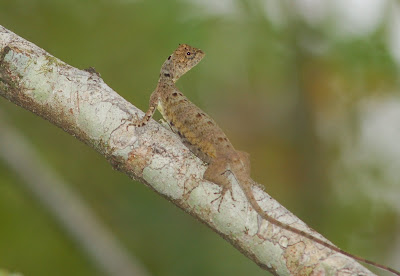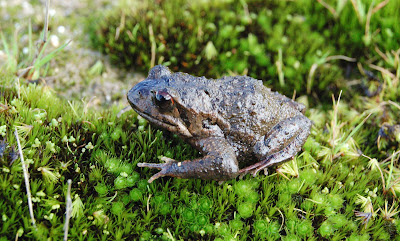.JPG)
These ranges are islands for fauna in basically a flat arid sea. As you can see it's often many kilometres across dry flats to the next island and therefore many fauna become endemic to a particular range.

The dry flat areas often have low sparse vegetation , except for creeklines such as this which provide many layers of habitat for various animals.

When not along major creeks or rivers with big eucalpyt trees, Wedge-tailed Eagles (Aquila audax) have to nest in the tallest trees they can find.
.JPG)
When we did our survey, this region of the Murchison had heavy rainfall from a cyclone only weeks before and lots of the vegetation was very green and flowering. Many plants such as this vine only appear after heavy rain.
A couple of the problems you encounter when doing a survey after heavy rain are lots of flies during the day and millions of mosquitoes at night. This area at that time was really bad, as the mosquitoes even attacked savagely during the day! All hungry for blood so they could lay their eggs before the water dried up.
.JPG)
One of the more common large skinks that live among the rocks of the ranges is the Rock Ctenotus (Ctenotus severus).
.JPG)
A harmless reptile egg eating snake that lives in the area is the North-western Shovel-nosed Snake (Brachyurophis approximans)
.JPG)
One of the geckos found in arid areas is this Fat-tailed Gecko (Diplodactylus conspicillatus). He often lives down vertical spider burrows (probably after eating the spider) and blocks the shaft with his broad tail as protection.
.JPG)
Due to lots of rocky habitat, these Pygmy Pythons (Antaresia perthensis) were quite common in the area.
.JPG)
Fauna surveys usually include catching or at least recording bat calls, so if your a bat expert like our fellow zoologist Brendan here, checking out old mining tunnels is part of the job.
.JPG)
Handling bats is generally for the bat experts, as some species carry a rabies-like virus.
.JPG)
Identifying fish species in the area is also part of the job, sometimes with great fun trying to catch them if you haven't got a net with you.
.JPG)
Usually we will stay in big well established mining camps, but sometimes you have to conduct surveys around exploration camps, such as this one. The transportable rooms (called 'dongas') were new and looked nice, but had no toilet or shower facilities connected yet. So the toilet was down the hill and the shower was that yellow canvas next to the caravan. A least there was hot water most of the time.
.JPG)
One of the beautiful rock outcrops found in the area, which are great homes for many animal species.
.JPG)
Not a setup photo. This is how we found them one morning. A rock with a Pygmy Python and a Rock Dragon (Ctenophorus caudicinctus) sunning themselves, or was the python hunting him?
.JPG)
.JPG)


































